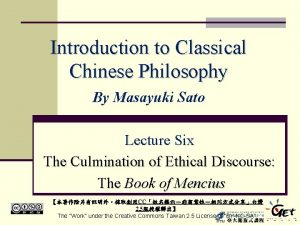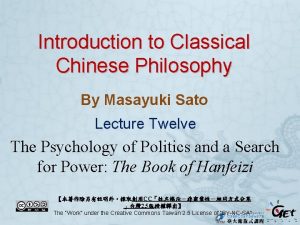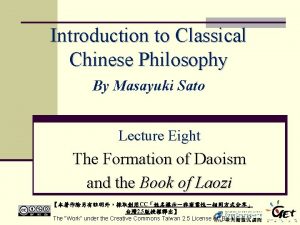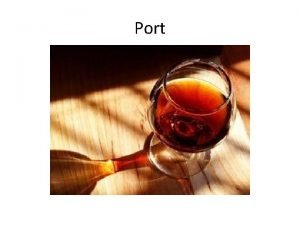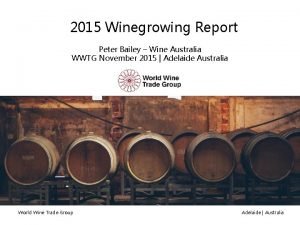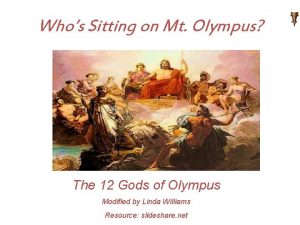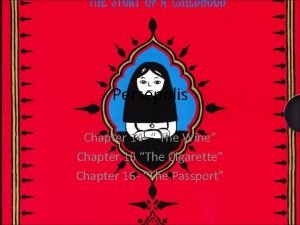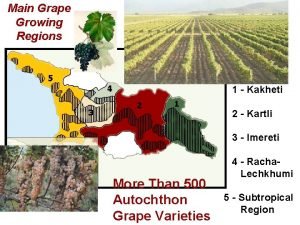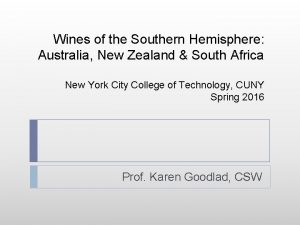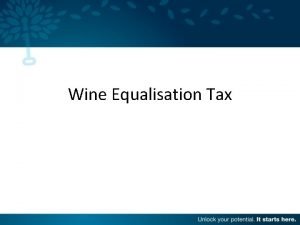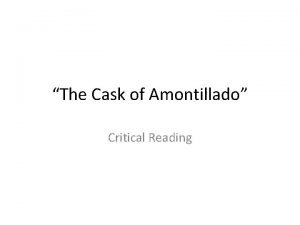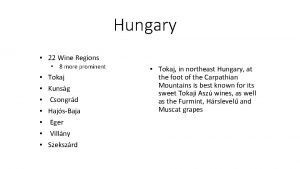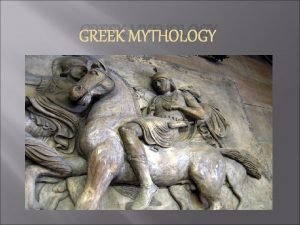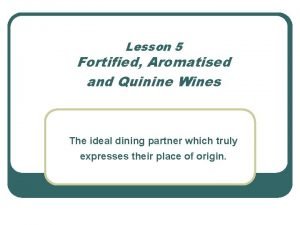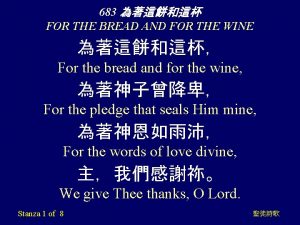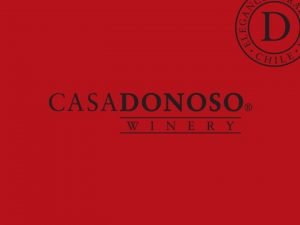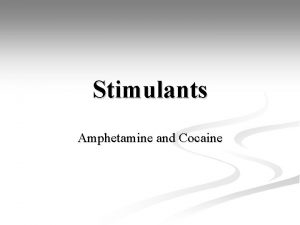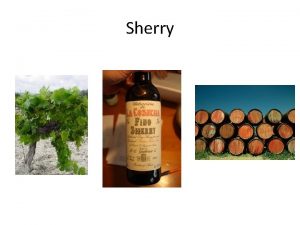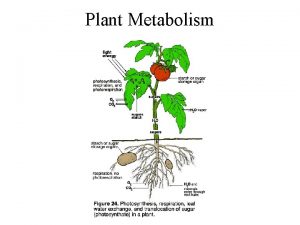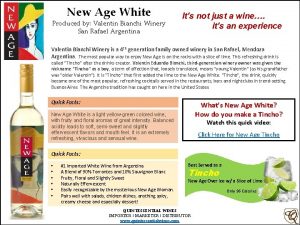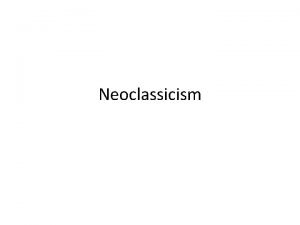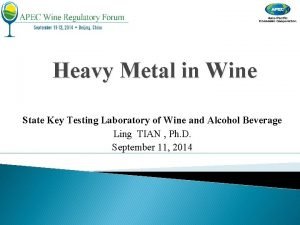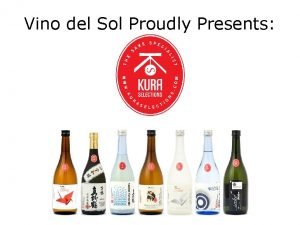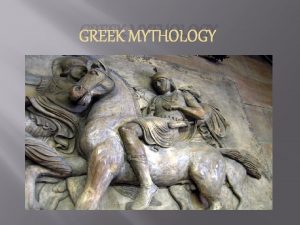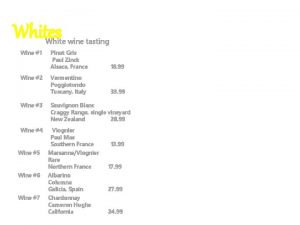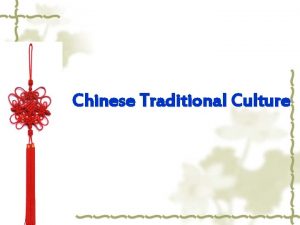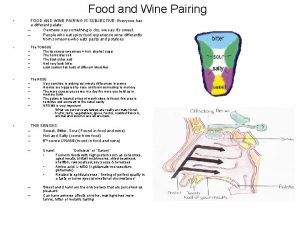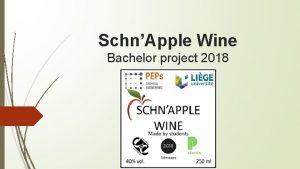Chinese LiquorWine Culture Chinese Wine Culture Introduction of




































































































- Slides: 100

Chinese Liquor/Wine Culture

Chinese Wine Culture Introduction of Chinese Wine The Origin of Chinese Wine Classification of Chinese Wine Famous Chinese Wines Occasions & Customs of Wine Drinking in China Drinking Etiquettes in China Chinese Poets with Wine The stories about wine

Introduction • Wine has a close connection with culture in China both in ancient and modern times. “Wine drinking is something of learning rather than eating and drinking. " • Wine has a history as long as that of mankind. According to legend, the Chinese people began to make wine with grains seven thousand years ago; with animal milk, ten thousand years ago.

• Wine has close connection with social customs in China. There are fifty-six nationalities in China and drinking customs vary from nationality to nationality. For instance, the Mongolians will present three cups of wine to a guest and go on singing songs of wine until the guest finishes them.

• Wine has been an inseparable part of the life of ordinary Chinese people through numerous events such as birthday, farewell dinner, wedding, etc. • Wine has also appealed to literary and refined scholars and many anecdotes about their drinking were handed down from generation to generation, such as li Bai, Tao Yuanming, etc.

The Origin of Chinese Wine • The origins of the alcoholic beverage from fermented grain in China cannot be traced definitively. A legend said that Yidi(仪狄), the wife of the first dynasty‘s king Yu(禹) invented the method. Another legend says that liquor was invented by Du Kang (杜康). At that time millet( was the main grain, the so-called "yellow liquor (huáng jiǔ黄酒)", then rice became more popular. It was not until the 19 th century that distilled drinks become more popular. Traditionally, Chinese distilled liquors are consumed together with food rather than drunk on their own.

Legends of Origin of Brewing Alcoholic Beverages the forefather of wine production in China Yidi (仪狄)

A Legend of Du Kang • It is said that Du Kang was also called Shaokang( 少康) and lived in the Xia Dynasty about 3900 years ago. He lived on graze (放牧)when he was young, and often forgot to have meals which he brought and hung on the tree. Later, he found that the taste of meal he left on the tree had changed, and the juices were especially luscious(甘美的). This interested him and made him think and study again and again. Finally, he learned the principle of natural fermentation and tried to improve his method. At last, a complete method of wine production was invented. Although this is only a legend, Du Kang was still regarded by later people as the forefather of wine production in China. Furthermore, wines are named “Du Kang Wine” by some people.


Classification of Chinese Wine • Grain-based Huangjiu and Choujiu (Fermented beverages) • Grain-based Baijiu (Distilled beverages) • Medicated Liquor • Fruit- based wines • Beer

medicated wine white wine yellow wine Beer fruit wine

Huangjiu("yellow liquor" ) • Huang Jiu predates all the other liquors, with a history of several thousand years. • Huangjiu is also known as “laojiu“(老酒), which is brewed from grain with wheat Qu(曲) or Xiao Qu( 小曲) used as fermenting agents. It is one of three dominated brewed wines (beer and grape wine) in the world.

• These wine are traditionally pasteurized(巴氏 消毒), aged(熟化), and filtered(过滤) before their final bottling for sale to consumers. • The alcohol content is mild, at around 15%. Huangjiu can also be distilled(蒸馏) to produce baijiu(white liquors) and it is used as the base of “yaojiu” (medicated liquors ). It is also an excellent condiment(佐料,调味品) for cooking. Among these liquors the Shaoxing Rice Wine is the most famous.

Traditional Wine Brewing It has a history of several thousand years and the traditional fermenting technique developed gradually into a mature level. Even in present day, the natural fermenting technique has not disappeared completely and something about such technique still remains a mystery.

Baijiu (White liquors ) • White liquors are also commonly called shaojiu (烧酒; lit. "hot liquor" or "burned liquor"), either because of the burning sensation in the mouth during consumption, the fact that they are usually warmed before being consumed, or because of the heating required for distillation.

Baijiu(“white liquor" ) • Baijiu, which includes spirits, is made from sorghum高 粱, corn, barley or wheat, most of which are easy to ferment. Colorless and transparent(透明的), Liquors of this type typically contain more than 30% alcohol in volume since they have undergone distillation. Some white liquors contain over 50% alcohol. The alcohol strength varies between 55 and 65 percent. A small quantity can make one tipsy(醉人的) in a moment. Of the most famous of baijiu are Guizhou Maotai, Wuliangye, Shanxi Fenjiu and Luzhou Daqu.

Type of Fragrance • While yellow liquors have a wide variety of classification methods, white liquors are grouped primarily by their type of fragrance. • There are three main groups of white liquors according to their characteristics due to the different fermentation methods. They are qingxiang(清香light fragrance), jiangxiang(酱香sauce fragrance) and nongxiang (浓香strong fragrance).

Liquor with light fragrance • Those that may ferment in clay vats缸 obtain a light and transient aroma芳香 and are called liquor with qingxiang, a light fragrance. A famous example of this is Fenjiu from Shanxi. •

Liquor with sauce fragrance • liquor with jiangxiang is made with yeasts that have been prepared under high temperatures, which also requires a larger amount of yeast than normally, ferments at a higher temperature. This yeast becomes very dark and gives the distillate a very special character that is comparable to the taste of sauce, and is consequently called, a sauce fragrance. A typical example of liquor with this taste is Maotai from Guizhou.

Liquor with strong fragrance • Liquors that are fermented in earth cellars(地窖) are affected by bacteria in the ground. This creates very special esters, acids and oils which are highly aromatic. Such liquor is called nongxiang, a strong fragrance. The three best ones are considered to be Mianzhu Daqu, Wuliangye from Yibin and Luzhou Laojiao Daqu. The production process is absolutely unique. They have the characteristics including full-flavor after taste, freshness and light sweetness. Every one will never forget the good taste even he only tastes a sip of it.

Medicated Liquor • Medicated liquor refers to a transparent medicated liquid obtained by using wine as a solvent to soak out the effective components of herbs. • Most medicated liquors are taken orally, while some are for external use. To improve the taste, crystal sugar or honey can be added to the medicated wine.

• Because liquor itself has the effect for stimulating blood circulation and relaxing muscles and joints, it can be used to treat general asthenia (loss of strength), rheumatic(风湿性的) pain, and traumatic(外伤的 ) injury. In addition, alcohol is a kind of good menstruum (solvent), which may distill (extract) a higher proportion of ingredients from medical material.

• Chinese people like to use precious medical material to make medical liquor, which can reinforce body fluid and nourish the blood. However, though medical liquor is good for the human body, it cannot be drunk superfluously. A frequency of 2 or 3 times a day with each dosage measuring 10 ml to 50 ml is proper for people.

Fruit Wine Classification: • A: Classified by grape: Wild Grape Wine Planted Grape Wine • B: Classified by color: White Wine Red Wine Rose Wine • C: Classified by content of sugar: Dry Wine Semi-dry Wine • D: Classified by carbonation : Pure Wine Sparkling Wine(汽酒) • E: Herbal Added Wine Classification • F: Brandy

Fruit Wine • A: Classified by grape: Wild Grape Wine : wine made from natural wild grape. Planted Grape Wine: wine made from different varieties of planted grapes

Fruit Wine • B: Classified by color White Wine: wine made from white grapes or light-red-skin grapes. Grape juice is separated from skin and only juice goes for fermentation to make wine. The color of this variety of wine starts from pale with green tinge, pale straw, straw to dark straw. Red Wine: wine made from redskin grapes. Grape juice and skin go for fermentation together first and then separated for winemaking. The color of this variety of wine starts from rose, ruby, rich ruby to plum and dark plum. Rose Wine: wine made from redskin white pulp grapes. Grape juice and skin go for fermentation together for a short period of time. When the juice gets the desired color, juice is separated from the skin and other residues for further fermentation and then made into rose wine.

Fruit Wine • C: Classified by content of sugar: Dry Wine: only little sugar is left after fermentation. The content of sugar is less than 4 grams per liter. The taste of wine is sour instead of sweet. Semi-dry Wine: the content of sugar is between 4 and 12 grams and the taste of the wine is a little sweet. 1. Semi-sweet Wine: the content of sugar is between 12 -50 grams and the taste of the wine is sweet and smooth. 2. Sweet Wine: the content of sugar is above 50 grams per liter and the taste of the wine is pure sweet.

Fruit Wine • D: Classified by carbonation 1. Pure Wine: wine which is free from carbon dioxides. 2. Sparkling Wine: wine which has carbon dioxides in it. Carbonated wine and champagne belong to this type.

Fruit Wine • E: Herbal Added Wine: wine that are added herbals which are good for stomach and spleen. For example, Changyu vermouth(苦艾酒) belongs to this type. Vermouth is made from an old variety of grapes and it is good for appetite.

Fruit Wine • F: Brandy: made from wine. They are distilled wine. The famous brandy is made in Cognac(柯涅克) in France. It was not until early 20 century that Changyu began for the first time in China to make and sell brandy both in China and abroad.

Chinese Beer • Generically, beer is any alcoholic beverage produced through the fermentation of starchy materials and which is not distilled after fermentation. • 啤酒以大麦芽、酒花、水为主要原料,经酵 母发酵作用酿制而成的,不经蒸馏,饱含二 氧化碳的低酒精度酒。

Primitive Beer in Ancient China ---"Li" • In ancient China, people consumed a kind of alcoholic drink called “Li“(醴 ) which was made from malted(麦芽 )cereals. Li has been considered as a type of primitive beer in remote ancient times. After Han Dynasty or so, Li was substituted by rice wine made by Qu ( it is called “曲” in Chinese). Then, Li, due to its low alcohol content, was obsolete from the banquet and even nobody knew exactly how Li was brewed.

• Li was first recorded in “Jia Gu Wen” ( inscription on bones or tortoise shells) in Shang Dynasty ( from 16 th century B. C. to 11 th century B. C. ). Although there were no complete descriptions about brewing process of Li, some characters and phrases carved on the bones or tortoise shells have been identified to be related to brewing process, such as “NIE”, meaning malted(麦芽) cereals or malting, “JIAN”, meaning “filtration(过滤, ). There were newly brewed Li and aged Li used on different occasions.

• In Zhou Dynasty, alcoholic beverages was classified into two types: rice wine and "Li". In Han Dynasty, Li was no longer the major alcoholic drink consumed because the rice wine brewing techniques was spreaded out everywhere. A kind of drink characterized by low alcohol and made with Qu in a short time was also called "Li", probably because of misunderstanding meaning of the original "Li";

• During the period of Northern and Southern Dynasty (420 - 581 A. D. ), Li made from malted cereals had been thoroughly absolete. Among more than 40 varieties of alcoholic drinks mentioned in << Qi Ming Yao Shu>>, there was no "Li", although the techniques for making wheat malt were described in detail. Now that rice wine made by Qu had the advantages of high proof of alcohol (usually 15% by volume), there was nothing strange that Li made from malted cereals had been substituted by rice wine.

• It is concluded that Li and beer should belong to the same type of beverage with much lower alcohol content than rice wine in remote ancient times. With the changes of times, the primitive beer, Li made from malted cereals disappeared in China.

Famous Chinese Wine At the First National Wine Appraisal Conference held in 1952, eight brands of famous Chinese wine were awarded a prize. They were • Guizhou Maotai茅台 • Shanxi Fenjiu汾酒 • Shaanxi Xifeng西凤 • Luzhou Laojiao泸州老窖 • Shaoxing Jiafan绍兴加饭酒 • Red Rose Grape Wine红玫瑰葡萄酒 • Weimeisi味美思酒 • Special Fine Brandy. 烟台金奖白兰地

Famous Chinese Wine At the Second National Wine Appraisal Conference held in 1963, eighteen brands of famous Chinese wine were warded a prize. Guizhou Maotai, Anhui Gujinggong, Shanxi Fenjiu, Quanxing Twice Fully-Fermented Liquor全兴大曲酒 (四川成都) Shaanxi Xifeng, Chinese Red Grape Wine Luzhou Laojiao. Twice Fully. Fermented Liquor 夜光杯中国红葡萄酒(北京)、 泸州老窖大曲酒 Shaoxing Jiafan绍兴加饭酒 Red Rose Grape Wine, Zhuyeqing竹叶青酒(山西汾阳杏花村)、 Qingdao White Grape Wine, Dongjiu董酒(贵州遵义)、 Yantai Weimeisi, Special-Made Bejing Brandy 北京特制白兰地 Yantai Special Fine Brandy, Chengang Liquor沉缸酒(福建龙岩) Sichuan Wuliangye Qingdao Beer

Famous Chinese Wine • In 1979, the Third National Wine Appraisal Conference was held and eighteen brands of famous Chinese wine were awarded a prize. Guizhou Maotai, Yantai Special Fine Brandy, Shanxi Fenjiu, Dongjiu, Sichuan Wuliangye, Special-Made Bejing Brandy, Anhui Gujinggong, Luzhou Laojiao Twice Fully. Fermented Liquor, Yanghe Twice Fully. Fermented Liquor, Shaoxing Jiafan, Jiannanchun, Zhuyeqing, Chinese Red Grape Wine, Qingdao Beer, Yantai Weimeisi, Yantai Red Grape Wine Qingdao White Grape Wine, Chengangjiu.

Some famous Chinese liquors • • • Maotai Liquor(茅台酒) Fen Liquor(汾酒) Five Grain Liquor(五粮液) Luzhou Liquor(泸州老窖特曲) Jiannanchun Liquor(剑南春) Xifeng Liquor(西凤酒) Gujinggong Liquor (古井贡酒) Dong Liquor(董酒) Shaoxing Wine Dukang Wine • Bamboo-Leaf Green Liquor

Maotai Liquor Maotai town, Renhuai county, Guizhou

Maotai Liquor • Maotai Liquor is produced in Maotai town, Renhuai county in Guizhou Province. Together with Scotch Whisky and French Cognac Brandy, it is renowned as one of the Three Famous Wines in the world. • 茅台英国苏格兰威士忌和法国柯涅克白兰地并 称为“世界三大名酒” • Due to the fragrance, purity, sweetness and refreshment, Maotai Liquor is regarded as the national liquor in China.

• Dating back to the Han Dynasty more than 2, 000 years ago, Maotai Liquor has a long history of brewage. As early as in the 18 th century of the Qing Dynasty (1644 -1911), Maotai became the first excellent wine brand in large-scale production, with an annual output of 170 tons, which was very rare in China's wine brewage history. Before the liberation, there were three main wine factories in Guizhou, whose products were respectively called Hua Mao, Wang Mao and Lai Mao, among which Hua Mao is the predecessor of today's Maotai Liquor. In 1915, Maotai Liquor was brought to Panama World Exposition and awarded the gold medal of the exposition.

• Maotai Liquor belongs to sauce fragrance style, ( 酱香型) tasting pure, sweet and refreshing. Maotai Liquor is made of wheat and sorghum. The brewage of the liquor will go though 8 times of ferment and 9 times of distillation, the whole process lasts one year. After the process, the liquor will be stored for years. The specific techniques of brewage make the strong liquor suitable for drinking and beneficial to the health. You won't feel dizzy even if you drink too much.


Fen Liquor Fenyang, Shanxi

Fen Liquor • The Fen Liquor is produced in Xinghua Village, Fenyang in Shanxi Province. Enjoying a history of more than 1, 500 years, it is the father of Chinese famous liquors. It uses the Yibazhua sorghum produced in Jinzhong Plain in Fenyang and the mellow Gujingjia Spring as ingredients. Through the process of brewing technology, the Fen Liquor is clear, crystal, mildly aromatic and affords a lingering after-taste. Due to its best quality, it is always praised as the excellent liquor and fluid precious stone.


Five Grain Liquor Yibin, Sichuan

Five Grain Liquor • The Five Grain Liquor, produced in Yibin, Sichuan Province, gets the name from its five ingredients, including sorghum, rice, glutinous rice, corn and wheat. The water is taken from the center of Minjiang River. The wrapped starter (Baobaoqu), produced by pure wheat, is used as the raising agent. When the bottle opens, a strong fragrance scents the air.


Luzhou Liquor Luzhou, Sichuan

Luzhou Liquor • is produced in Luzhou, Sichuan Province. In the early Qing Dynasty (1644 -1911), Wenyongsheng and Tianchensheng were the two liquor factories that produced Luzhou Liquor. The oldest cellar of Wenyongsheng has a history of more than 370 years. • Luzhou Liquor features strong aroma, sweet, raw and has a long, persistent finish. It has become the model of strong aromatic Chinese spirits.


Jiannanchun Liquor The ruin of liquor cellar, Mianzhu, Sichuan

Jiannanchun Liquor • Jiannanchun Liquor is produced in the Mianzhu county, Sichuan Province. It is one of the famous liquors in China that enjoys a long history. In Tang Dynasty (618 -907), "chun (春)" was used to name the wine, hence the name. According to the legend, the great poet Li Bai in Tang Dynasty once used the golden crown in exchange for Jiannanchun, which reflected the excellent quality of the liquor. • Jiannanchun Liquor is made from sorghum, rice, glutinous rice, corn and wheat. It is finely brewed in traditional technique and can be divided into 62 degrees and 52 degrees. Every drop is fragrant, mellow, sweet and cool with a long finish.


Xifeng Liquor Clay sculpture, Fengxiang, Shaanxi

Xifeng Liquor • Being one of the oldest liquors in China and in the world, Xifeng Liquor is produced in Liulin town, Fengxiang county, Shaanxi Province. In the late Shang Dynasty (C. 1600– 1046 BC), in order to celebrate the victory of Muye Battle, the King of Zhouwu used Qin Liquor (today's Xifeng Liquor) to reward his soldiers. Xifeng Liquor represents the Feng-style liquor blends the five flavors: sour, sweet, bitter, spicy and fragrant. The liquor degrees are divided into 39 degrees, 55 degrees and 65 degrees.


Gujinggong Liquor Bozhou, Anhui

Gujinggong Liquor • Gujinggong Liquor is produced in Bozhou, Anhui Province. "Gujing" means ancient well. There is an ancient well having a history of 1, 400 years in the liquor factory. The local water tastes bitter but the spring from this well is quite sweet. The liquor made from the spring of the well has a wonderful flavor. During Wanli's rule in Ming Dynasty (1368 -1644), it became a tribute.


Dong Liquor Zunyi, Guizhou

Dong Liquor • Dong Liquor is produced in Dong Liquor Factory in Zunyi, Guizhou Province. It gets the name from the Donggong Temple near the factory. Dong Liquor is the most special Chinese liquor in brewing method. It is made from the best glutinous Indian millet(黍, ) and the underground springs from Shuikou Temple. It blends the styles of Daqu Liquor and Xiaoqu Liquor.


Some Other Famous Chinese Wines • Shaoxing Wine • Dukang Wine • Bamboo-Leaf Green Liquor

Shaoxing Wine • Shaoxing Wine, also called Huang Jiu (yellow wine), produced in the town of Shaoxing, Zhejiang Province, It has been known for its flavor and golden colour.

Dukang Wine bears the same name of its production site - Dukang village in Henan Province, which has the charms of historical relics and the pureness of nature. The wine has been popular among the Chinese people for more than 2, 500 years. It may not only arouse your deepseated nostalgia乡愁 for the ancient past, but also give you a natural enjoyment by relieving your anxiety. Dukang Wine is as good to health as it is to prolonging life.

Bamboo-Leaf Green Liquor Bamboo-leaf green liquor is another of the eight famous Chinese wines. It is made by immersing bamboo leaves and dozens of medicinal herbs, such as Chinese angelica and cap jasmine in Fen Liquor. The wine is pale green, translucent and fragrant. It has a reputation for improving health and treating such diseases as heart trouble, high blood pressure and arthritis.

Occasions & Customs of Wine Drinking in China • Wedding wine • longevity wine • Welcome wine • Farewell Wine “Opening wine” and “dividend wine” • Realgar Wine(雄黄酒)On May 5 th • Chrysanthemum Wine on September 9 th • Wine drinking during Spring Festival, the Lantern Festival, the Mid- Autumn Festival and other happy occasions • …

longevity wine • China is a typical country that emphasize the virtue of respecting older people. . And there are various ways to reach it, among which is to present “longevity wine”. When an old person’s birthday comes, younger generation usually take different kinds of gifts to celebrate them. Taking wine and eat a meal with them is very popular and welcomed by older generation. Here wine acts as a medium to transfer love and wishes.

Occasions for Drinking Wine • to celebrate different festivals, wedding ceremonies and birthday; • to memorize the departed; • to welcome and send off relatives and friends; • to congratulate the good news ; • to get rid of anxiety; • to cure diseases and prolong life

“Opening wine” and “dividend wine” • In China, if you are the boss of a new store or company, before you open you business, you should hold a great banquet to celebrate. You could call your relatives and friends together , then your business will be good later. Not only starting a business needs wine, at the end of the year, when the boss is ready to give the workers dividend( 红利) to thank them for their hard working, a wine works , too.

Drinking Etiquette • When entertaining guests with wine, drip the wine to the wine cup to its full length. • It is hospitable to urge guests to drink more. • The person who proposes a toast to others, especially to the old and VIPs should finish the drinking first.

Drinking Etiquette • At a feast, the host or guest should present a short speech to express his good will when inviting others to drink; sometimes, one of guests could stand up to invite the rest at the feast to have a drink one by one. When inviting others to drink, the inviter and invitee should both stand from their seats. Invitation of others to drink is usually limited to three cups.

Jiuling Called in Chinese 酒令 (The drinking game; the drinkers’ wager game ) • At the very beginning, alcohol was mainly a beverage in the ceremonial rites. The drinking games, Jiuling called in Chinese, were just aids for drinking. Certainly there were other aids for drinking, such as archery, chess playing and arrow pitching. Aimed to restrict overdrinking to keep drinkers be gentlemen and preserve courtesy of the time, there were even special designated officials to manage these aids for drinking. Later, drinking games which added entertainment to rites, gradually became artifice to persuade, wager and force overdrinking. Jiuling is a unique part of Chinese culture.

• Now Jiuling has many forms, depending on the drinker's social status, literacy status and interests, which can be classified into three categories - general game, contest game and literal game. General game includes those games every body can play, such as joke telling, riddling and Chuanhua (passing flowers one by one). This category usually appears on banquet for ladies.

• Animal betting is a very interesting game every Chinese can play. In the game, one uses his Chopstick to tap the other player's chopstick and at the same time speaks out one of four terms. The other does the same. There are four terms: stick, tiger, cock and insect. The regulations are simple: Stick beats tiger; tiger eats cock; cock pecks insect; insect bores stick. Literal game is mainly popular in bookworms since they receive good education and have refined knowledge and know the essence of Chinese traditional culture. Intellectuals sometimes play the other two category drinking games too, however they consider those games vulgar. Beaux-esprit and cultured ladies prefer the elegant game, literal game.

• Usually literal game is unique and artful literal contest, which requires superior wisdom, broad knowledge sphere and fast response. In order to animate atmosphere, players will do their best to produce original, novel, unpredicted and extremely fine literal pieces, with quotations from scriptures, history, poems, proverbs, and fairy tales embedded. Many Jiulings of this category, very artistic, are pleasingly worthy of literary appreciation. Bai Juyi, one of Chinese greatest poets, even thought elegant Jiuling was much more interesting than music accompaniment.

• Contest game consists of archery, arrow pitching, chess playing, dicing, finger guessing and animal betting. Among these, the latter two are common ;In finger guessing, two players stretch out their right hands, with several fingers sticking out while the others closing to their palm and at the same time, each of them, usually roars a number from nil to ten. If fingers sticking out adds up and the sum equals to a player's number, then he wins and the loser will have to drink. There are many differences in different regions.




Liangzhou word ? 征醉 战卧 几沙 人场 回君 莫 笑 , 古 来 琵葡王 琶萄翰 马美凉 上酒州 催 。夜 光词 杯 , 欲 饮 · From cups of jade that glow with wine of grapes at night, Drinking to pipa songs, we are summoned to fight. Don't laugh if we lie drunk upon the battleground! How many warriors ever came back safe and sound?










The Stories about Wine There are many stories about wine in Chinese history. Tao Yuanming, a poet in the Jin dynasty, could not live without wine for a day.

The great poet Li Bai in the Tang Dynasty, could “write 100 poems after drinking wine”, the more wine he drunk, the better the poem would be.

Wu Song, a brave man from Liangshan in the Song Dynasty, drank 18 bowls of wine without a break, and then, barehanded, fought a fierce tiger to the death.

Liangzhou word ? 征醉 战卧 几沙 人场 回君 莫 笑 , 古 来 琵葡王 琶萄翰 马美凉 上酒州 催 。夜 光词 杯 , 欲 饮 · From cups of jade that glow with wine of grapes at night, Drinking to pipa songs, we are summoned to fight. Don't laugh if we lie drunk upon the battleground! How many warriors ever came back safe and sound?

Questions for discussion: • What do you think of the wine-drinking customs in China? Give examples to support your idea.

 Primary 3 malay worksheets
Primary 3 malay worksheets Language in life
Language in life Spice t chart song dynasty
Spice t chart song dynasty Introduction to classical chinese philosophy
Introduction to classical chinese philosophy Introduction to classical chinese philosophy
Introduction to classical chinese philosophy Introduction to classical chinese philosophy
Introduction to classical chinese philosophy Serving temperature of white wine
Serving temperature of white wine Csw wine
Csw wine Portuguese fortified wine
Portuguese fortified wine Water you turned into wine
Water you turned into wine God of wine and party
God of wine and party Wine export certificate
Wine export certificate Blue ocean strategy focus divergence and compelling tagline
Blue ocean strategy focus divergence and compelling tagline Goblet wine tureen
Goblet wine tureen Dandelion wine summary
Dandelion wine summary Peter bailey wine
Peter bailey wine Fresh oil, new wine scripture
Fresh oil, new wine scripture Simon somogyi
Simon somogyi Whos zeus wife
Whos zeus wife Water you turned into wine open the eyes of the blind
Water you turned into wine open the eyes of the blind Porthos wine concierge
Porthos wine concierge Jesus turns water into wine lesson
Jesus turns water into wine lesson Circular acceleration
Circular acceleration Are cell walls prokaryotic or eukaryotic
Are cell walls prokaryotic or eukaryotic What does the wine symbolize in persepolis
What does the wine symbolize in persepolis Gare kakheti wines
Gare kakheti wines Yellow tail wine blue ocean
Yellow tail wine blue ocean Wineberry box wine
Wineberry box wine Wine consumer demographics
Wine consumer demographics Wine exports
Wine exports Benevolent demon
Benevolent demon Wine exports
Wine exports Wine equalisation tax example
Wine equalisation tax example Washington wine association
Washington wine association Dylans wine cellar
Dylans wine cellar Locate and write down a line that includes verbal irony.
Locate and write down a line that includes verbal irony. Mermaid's wine glass
Mermaid's wine glass Paulo prisioneiro de jesus cristo
Paulo prisioneiro de jesus cristo Wine mouthfeel
Wine mouthfeel Wine rice indigo silk tobacco
Wine rice indigo silk tobacco International wine associates
International wine associates Primorska wine region
Primorska wine region Haccp for wine production
Haccp for wine production Artemis realm and symbol
Artemis realm and symbol Wine 1659
Wine 1659 Wine startups
Wine startups Is wine a homogeneous mixture
Is wine a homogeneous mixture Pierrot wine
Pierrot wine Mosetto wine
Mosetto wine Site:slidetodoc.com
Site:slidetodoc.com Wine with quinine
Wine with quinine All greek wine
All greek wine Ito ay ginagamit sa pagsusukat ng mga mananahi
Ito ay ginagamit sa pagsusukat ng mga mananahi Who is the god of wine and revelry
Who is the god of wine and revelry From tasting to digesting
From tasting to digesting Countable and uncountable nouns exercise
Countable and uncountable nouns exercise Wine ltspice
Wine ltspice Wine valleys in california
Wine valleys in california Cswg export wine
Cswg export wine Argentine wine regions
Argentine wine regions A merchant mixes three varieties of rice costing
A merchant mixes three varieties of rice costing Wine objectives
Wine objectives For the bread and for the wine
For the bread and for the wine Wine market council
Wine market council Jarhead red wine
Jarhead red wine Casa donoso wine
Casa donoso wine Titulus wine
Titulus wine Diyarbakir wines
Diyarbakir wines Rising sun sign ent
Rising sun sign ent Mariani wine
Mariani wine Tulip shaped sherry glass
Tulip shaped sherry glass Karen goodlad
Karen goodlad What are tannins
What are tannins Water you turned into wine
Water you turned into wine New age wine calories
New age wine calories Clodion
Clodion Ben salisbury wine
Ben salisbury wine Wine and beverage management
Wine and beverage management King chancho sauvignon blanc
King chancho sauvignon blanc Bulk wine shipping
Bulk wine shipping Stages of biotechnology
Stages of biotechnology Wine testing laboratory
Wine testing laboratory Wallaroo trail pinot grigio saq
Wallaroo trail pinot grigio saq Lunzer wine events
Lunzer wine events Manotsuru demon slayer sake
Manotsuru demon slayer sake Zipz wine vs copa de vino
Zipz wine vs copa de vino Penfolds wine v elliott
Penfolds wine v elliott Wine powershell
Wine powershell Hestia roman name
Hestia roman name Baby mice wine korea
Baby mice wine korea Amoroni wine
Amoroni wine Cultural relativism definition
Cultural relativism definition Individual culture traits combine to form culture patterns.
Individual culture traits combine to form culture patterns. Batch culture vs continuous culture
Batch culture vs continuous culture Fed-batch
Fed-batch Individualistic culture definition
Individualistic culture definition American vs indian culture
American vs indian culture Stab culture and stroke culture
Stab culture and stroke culture Folk culture and popular culture venn diagram
Folk culture and popular culture venn diagram Vocational subculture
Vocational subculture How does popular culture diffuse
How does popular culture diffuse



